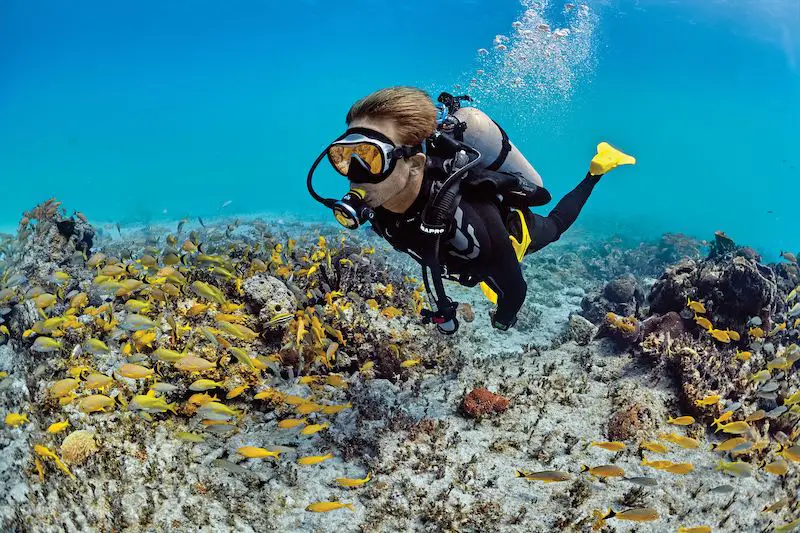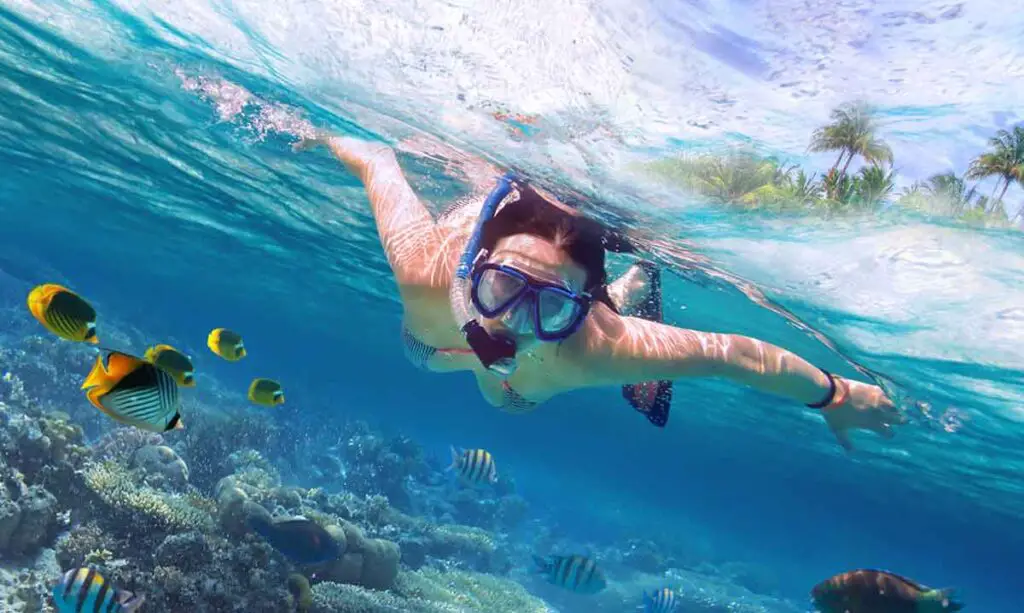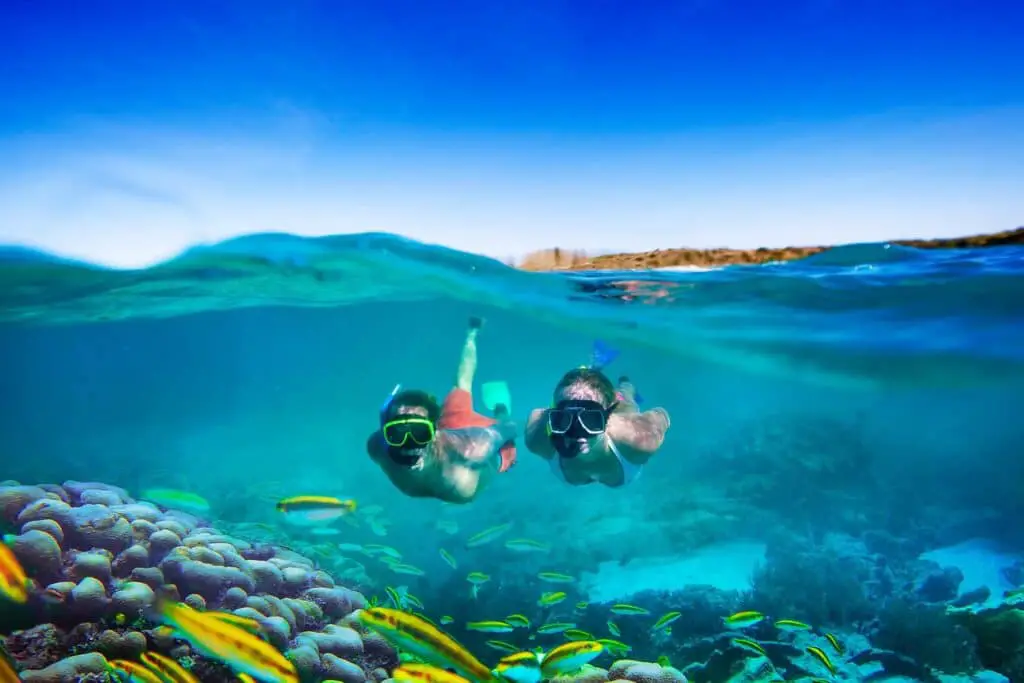How To Use Snorkeling Gear

Introduction
How To Use Snorkeling Gear: Snorkeling is a captivating way to explore the wonders of the underwater world without the need for complex scuba diving equipment. With just a few basic tools and techniques, you can immerse yourself in the vibrant marine ecosystems, observing colorful fish, exotic coral reefs, and other mesmerizing marine life.
Using snorkeling gear effectively is essential for a safe and enjoyable experience. This introductory guide will walk you through the fundamental aspects of using snorkeling gear, ensuring that you are well-prepared to venture beneath the surface with confidence.
Snorkeling gear primarily consists of a mask, snorkel, and fins. Each of these components plays a vital role in enhancing your underwater experience. The mask provides a clear view of the aquatic world, the snorkel enables you to breathe while floating face-down, and the fins facilitate smooth and efficient movement through the water.
But knowing how to use this equipment correctly is key. Properly fitting and defogging your mask, mastering the art of breathing through the snorkel, and using your fins for propulsion are all skills that will make your snorkeling adventure not only comfortable but also safe.
Understanding water conditions, safety precautions, and environmental conservation practices are equally important aspects of snorkeling. By the end of this guide, you’ll be equipped with the knowledge and skills necessary to embark on unforgettable snorkeling journeys and discover the beauty that lies beneath the ocean’s surface.

Can you breathe underwater with snorkeling gear?
Unlike scuba diving where you have your own air supply, snorkels don’t let you breathe while you are fully submerged in the water.
Snorkeling gear does not enable you to breathe underwater. Snorkeling gear, including a mask and snorkel, allows you to remain submerged with your face in the water while breathing through the snorkel tube. It provides a way to observe the underwater world while keeping your airway above the surface.
The mask creates an airtight seal around your eyes and nose, allowing you to see clearly underwater. The snorkel, which extends above the water’s surface, lets you breathe in fresh air while floating face-down. This simple but effective combination allows you to enjoy extended periods of time exploring the ocean’s beauty without the need for scuba diving equipment or tanks.
It’s crucial to understand that snorkeling is limited to shallow depths and relies on surface-supplied air. If you want to explore deeper underwater environments for an extended period, you would need scuba diving equipment, which includes a tank of compressed air and specialized breathing apparatus. Snorkeling gear is perfect for enjoying the vibrant life in shallower waters, making it an accessible and popular choice for recreational underwater enthusiasts.
How long do snorkelers hold their breath?
Even if you are an experienced snorkeler who is going out in perfect conditions, we don’t recommend diving for more than 2 minutes. Remember, snorkels are designed to be used floating above the water, with only limited time to be spent actually underwater.
The duration snorkelers can hold their breath underwater varies widely from person to person and depends on several factors. On average, most casual snorkelers can hold their breath comfortably for about 30 seconds to 2 minutes. However, with practice, breath-holding capacity can be extended. Factors influencing how long a snorkeler can hold their breath include:
- Fitness Level: Individuals who are in better physical shape tend to have greater lung capacity and can hold their breath for longer periods.
- Relaxation: Staying calm and relaxed underwater is crucial for extending breath-holding time. Anxiety or nervousness can lead to shorter breath-holding durations.
- Experience: Experienced snorkelers often develop better breath control techniques, allowing them to stay submerged for longer periods.
- Breathing Technique: Learning efficient breathing techniques, such as deep diaphragmatic breathing, can help increase breath-holding capacity.
- Water Temperature: Cold water can reduce breath-holding time as the body expends more energy to stay warm.
- Physical Activity: Physical exertion while snorkeling, like swimming against strong currents, can shorten breath-holding times.
Always practice safe snorkeling techniques and return to the surface for regular breaths. Additionally, never snorkel alone, and be aware of your surroundings and the conditions of the underwater environment to ensure a safe and enjoyable experience.
Do you get oxygen when snorkeling?
The actual act of snorkeling is when a person uses equipment like a snorkel tube to breathe near the surface of the water while their face is submerged wearing a glass lens mask to see underwater. You do not need oxygen tanks or any expensive equipment to enjoy snorkeling.
While snorkeling, you do receive oxygen, but not from an external source like scuba diving tanks. Instead, you rely on the oxygen in the surrounding air. Snorkeling equipment, including a mask and snorkel, allows you to breathe while floating face-down on the water’s surface.
The snorkel is a tube that extends above the water, allowing you to inhale fresh air and exhale underwater. This simple yet effective design lets you explore the underwater world without the need for heavy scuba diving gear or compressed air tanks.
It’s important to note that snorkeling is limited to relatively shallow depths, typically no more than a few feet below the surface. This is because the snorkel’s tube is not long enough to supply air at significant depths. Snorkeling is a popular choice for casual and recreational underwater exploration, perfect for observing marine life, exploring coral reefs, and enjoying the tranquility of the ocean’s upper layers.
For deeper and more extended underwater adventures, scuba diving is the preferred option. Scuba divers use specialized equipment that includes a tank of compressed air or other breathing gases to access greater depths and remain submerged for longer periods while receiving a continuous supply of oxygen.
What gear do you need to snorkel?
All you really need is a snorkel, mask, and fins. That’s it! Although, if you’re snorkeling in cooler waters like California or higher UV areas such as Southern Florida and the Bahamas, you may want to consider wetsuits, rashguards, and reef-safe sunblock as well.
To enjoy a safe and fulfilling snorkeling experience, you’ll need a set of essential gear designed to enhance your comfort and safety while exploring underwater. Here’s a breakdown of the gear you need to snorkel:
- Mask: A snorkeling mask creates an airtight seal around your eyes and nose, allowing you to see clearly underwater. Choose a mask that fits snugly and comfortably to prevent water from entering.
- Snorkel: The snorkel is a tube that enables you to breathe while floating face-down on the water’s surface. Look for a snorkel with a comfortable mouthpiece and a purge valve to clear any water that enters the tube.
- Fins: Snorkeling fins help you move through the water with ease and efficiency. They come in various styles, including full-foot and adjustable heel strap designs. Properly fitted fins can make a significant difference in your underwater maneuverability.
- Wetsuit or Rash Guard: Depending on the water temperature, you might need a wetsuit or a rash guard to provide thermal insulation and protect your skin from the sun and potential stings from marine life.
- Flotation Device: Some snorkelers use flotation devices like vests or belts to help them stay afloat comfortably without expending too much energy.
- Optional Accessories: Depending on your preferences, you can also consider accessories like underwater cameras, snorkel vests, or booties for added comfort and functionality.
What to look for when buying a snorkel gear?
Look for masks that feature tempered glass lenses, double silicone skirts and wide, comfortable head straps with easy to adjust buckles. Depending on your personal preference and face features, options include single or double lens, side lenses, purge valve, black or clear silicone skirt..
When embarking on the exciting adventure of buying snorkel gear, there are several key factors to consider to ensure a safe and enjoyable underwater experience. Firstly, prioritize the fit and comfort of the mask, as it plays a pivotal role in your snorkeling escapades. Opt for a mask that seals well against your face, has a soft silicone skirt, and a comfortable strap, ensuring it doesn’t leak or cause discomfort during extended use.
The snorkel itself is equally crucial. Look for a snorkel with a comfortable mouthpiece that allows effortless breathing and a purge valve to easily expel any water that may enter the tube. A snorkel with a flexible, ergonomic design will make your underwater explorations more enjoyable.
Fins are another critical component of snorkel gear. Choose fins that fit snugly but comfortably and provide efficient propulsion through the water. Adjustable straps on the fins allow for a customized fit and easy donning and doffing.
Consider the material and durability of your gear. High-quality, corrosion-resistant materials like silicone and tempered glass for masks, along with rugged construction for snorkels and fins, ensure your equipment stands up to the test of time.
When buying snorkel gear, prioritize comfort, fit, functionality, and durability. A well-chosen set of gear will enhance your snorkeling adventures and make them all the more memorable.
How do I choose the right snorkel mask?
Selecting the perfect snorkel mask is crucial for an enjoyable and hassle-free underwater experience. When choosing the right snorkel mask, consider the following factors:
- Fit and Comfort: The most important aspect is finding a mask that fits your face snugly without causing discomfort. Look for masks with a soft silicone skirt that creates a good seal around your face. Try on different styles and sizes to ensure a comfortable fit.
- Lens Material: Opt for a mask with lenses made of tempered glass. Tempered glass is more durable and less likely to shatter underwater than plastic lenses. It also offers better optical clarity for a clear view of the underwater world.
- Low-Volume Design: Masks with a low-volume design sit closer to your face, making it easier to equalize pressure and clear water from the mask. They also reduce the overall drag when snorkeling.
- Wide Field of View: Choose a mask with a wide field of view to enhance your underwater exploration. Masks with larger lenses or side windows provide better peripheral vision.
- Easy Adjustment: Look for masks with easily adjustable straps for a secure and customized fit. Quick-release buckles and swiveling mask straps are convenient features.
Remember that the right snorkel mask may vary from person to person due to differences in face shape and preferences. It’s essential to try on several options and test them in the water if possible to find the mask that best suits your needs and provides a comfortable, clear, and enjoyable snorkeling experience.
What’s the proper way to use a snorkel?
Using a snorkel effectively is essential for an enjoyable and safe underwater experience. To make the most of your snorkeling adventure, follow these steps to ensure proper usage.
- Select the Right Snorkel: Choose a snorkel that fits comfortably in your mouth and has a purge valve at the bottom to clear water easily.
- Adjust the Mask: Ensure your mask fits snugly and creates a watertight seal around your face. The mask and snorkel should work together seamlessly.
- Position the Snorkel: Place the snorkel in your mouth, gripping it gently with your teeth. Keep your lips sealed around it to prevent water from entering.
- Practice Breathing: Start by breathing slowly and deeply through the snorkel tube. Practice in shallow water first to get comfortable with this new way of breathing.
- Stay Horizontal: Keep your body horizontal while floating on the surface of the water. This allows the snorkel to remain above the waterline, ensuring a steady airflow.
By following these guidelines, you’ll be well-equipped to make the most of your snorkeling experience while ensuring your safety in the water.
What safety precautions should I take while snorkeling?
When embarking on a snorkeling adventure, ensuring your safety should be a top priority. First and foremost, it’s crucial to be a confident swimmer. Familiarize yourself with the equipment, especially the mask, snorkel, and fins, to ensure they fit snugly and comfortably.
Before entering the ocean or any body of water, assess the conditions. Check for strong currents, waves, or weather warnings, and never snorkel alone – always have a buddy with you. Familiarize yourself with the area’s marine life and potential hazards. Be cautious around coral reefs, as touching or damaging them can harm both you and the delicate ecosystem.
Maintain a calm and controlled breathing pattern while snorkeling to conserve energy and reduce the risk of hyperventilation. Avoid holding your breath for prolonged periods, and if you need to surface, do so gradually to prevent barotrauma. Additionally, always stay close to the surface and never dive too deep without proper training and equipment.
Wear a brightly colored snorkel vest or buoyancy aid to increase your visibility to boats and other snorkelers. By following these safety precautions, you can enjoy the wonders of the underwater world while minimizing risks and ensuring a safe and enjoyable snorkeling experience.

Conclusion
In the world of aquatic exploration, snorkeling stands out as a truly accessible and enchanting experience. As we conclude our journey through the fundamentals of using snorkeling gear, it’s clear that this activity offers a gateway to a mesmerizing realm of underwater beauty.
Mastering the art of using snorkeling gear is not just about understanding the mechanics of a mask, snorkel, and fins; it’s about unlocking a world of wonder beneath the waves. The mask, which allows you to see with crystal clarity, reveals the intricate ecosystems of coral reefs and the graceful dance of marine life.
However, snorkeling is more than just a technical endeavor. It’s a harmonious blend of skill, respect for nature, and a deep connection with the aquatic environment. It’s a chance to witness the majesty of the ocean’s inhabitants and to develop a profound appreciation for the fragility of these ecosystems.
So, armed with the knowledge of how to use snorkeling gear and an understanding of the importance of conservation, you’re now prepared to embark on incredible underwater adventures. As you venture forth into the depths, remember to tread lightly, explore responsibly, and cherish the privilege of being a guest in this awe-inspiring world beneath the waves.



